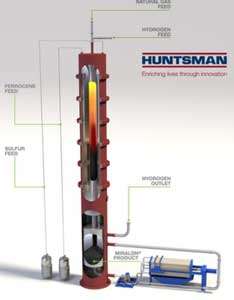 Huntsman Corporation has announced construction has commenced on the 30-tonne Miralon carbon nanotube materials plant, originally announced in 2021. The new plant, which converts methane gas to carbon nanotubes and clean-burning hydrogen, will be one of the largest of its kind in the Americas. It represents a major step forward in the commercialisation of the Miralon technology and another step closer to an industrial-scale production facility.
Huntsman Corporation has announced construction has commenced on the 30-tonne Miralon carbon nanotube materials plant, originally announced in 2021. The new plant, which converts methane gas to carbon nanotubes and clean-burning hydrogen, will be one of the largest of its kind in the Americas. It represents a major step forward in the commercialisation of the Miralon technology and another step closer to an industrial-scale production facility.
The new plant is expected to be completed by year-end 2023,
Miralon structural carbon products are carbon nanotube-based advanced materials, which can be produced as sheets, tape, yarn, or additives and dispersions.
Thinner than a human hair and up to 25 times stronger than steel, the carbon nanotube materials are lightweight and electrically and thermally conductive – attributes that can benefit a wide variety of applications in aerospace, automotive, construction and other industries.
The carbon nanotube materials can be used in electric vehicle batteries, high-performance composites, engineered thermoplastics, conductive adhesives, specialised concrete, and longer-wear tyres.
“One of the interesting aspects of this project is that there are actually two valuable products created through the technology,” said David Hatrick, Vice President of Innovation and Strategic Marketing for Huntsman’s Advanced Materials division. “The first product is the Miralon carbon nanotube materials which have tremendous opportunity to create better products and new applications that don’t even exist today. The second product resulting from the process is clean hydrogen – a fuel in high demand as society collectively seeks to lower CO2 emissions and accelerate the energy transition.”
The manufacturing process produces clean hydrogen as a by-product, with little to no CO2 emissions. This can play an exciting role in energy transition by minimising the carbon footprint of many industries, explained John Fraser, Commercial Director for Miralon technology and materials.
“The carbon footprint related to our manufacturing process can be up to 95% less, when compared to the traditional process of steam methane reforming (SMR), avoiding the majority CO2 emissions normally associated with hydrogen production,” Fraser said.
“Co-locating a small Miralon manufacturing unit on a customer’s site, creates the opportunity to produce hydrogen right where our customers need it. This will allow companies to reduce their carbon footprint and benefit from the potential of CO2 sequestration/capture credits.”
